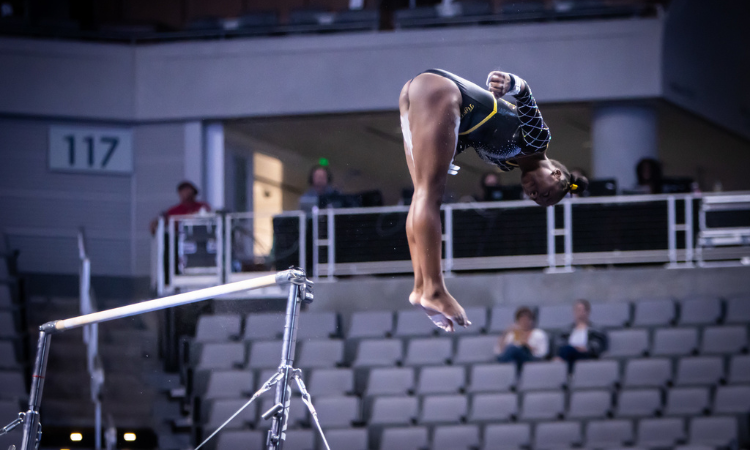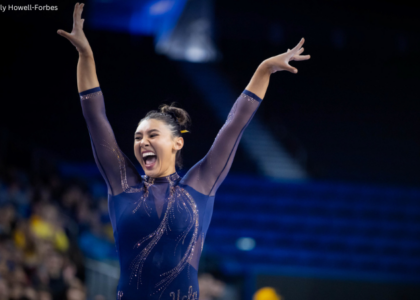The NCAA Women’s Gymnastics Committee released its annual meeting rules discussion minutes from the meeting on June 6, as well as the complete minutes. We examined some of the biggest and most surprising changes. Keep in mind that the NCAA still needs to ratify the changes, but it’s likely that these rules will stand.
Vault Start Values
The committee voted to change the start value for a handful of vaults to better reflect their difficulty and be more consistent with the rest of the code, including handspring front tuck (now 9.95 start from 9.90), handspring half-on back tuck (now 9.95 start from 9.90), and Yurchenko full-on back tuck (now 9.95 from 10.0).
The most notable change is the devaluation of the Yurchenko full-on back tuck. This will alter the game plan of several gymnasts, like West Virginia’s Gillian Fletcher and BYU’s Elease Rollins, who now need to upgrade to a pike or layout to return to starting from a 10.0.
Vault Landing Mat Directional Lines
To assist judges in assessing directional deductions, lines will be added to landing mats on vault for a visual aid to evaluate a gymnast’s distance and orientation. The lines will be taped or drawn in chalk onto the mat in a funnel shape stemming from the table, and, as of now, the language suggests there will be no center line and only side lines.
The biggest thing to note here is that, unlike in elite, there is no flat deduction for stepping over a directional line on landing. The lines are simply to act as a visual guide for judges to take the current directional deduction, which can be up to three tenths of a point. With directional deductions seemingly absent from scores in years past, it will be interesting to see how strict judges are in assessing short or crooked vaults.
Raising Bars Dismount Values from C to D
Prepare to see fewer backwards-flipping bars dismounts this season as a trio of forward saltos were upgraded in value from C to D to give gymnasts a larger variety of dismounts to choose from to fulfill requirements. These dismounts include the toe-on front pike half, back stalder to tuck half or pike half, and clear support to tuck half or pike half.
The most significant change for gymnasts already competing this style of dismount is no-longer needing to connect them for their routine to be up to level. For example, Missouri’s Amari Celestine can now stick her dismount without having to perform a stadler immediately before it.
Beam will Require a Minimum C Dismount
In an attempt to mirror the dismount requirements of bars and floor, dismounts on beam must now be valued at a C or higher. This change ends the side aerial to back full dismount era, as dismounting with a D acro element connected to a B dismount is no longer up to the level. Along with this change, the double full dismount was upgraded from C to D, so expect to see a few more gymnasts dismounting with that in the coming seasons.
Yellow Card Procedures
Handing out warning cards like fans often see in soccer is a rarity in gymnastics. Some fans may not even know it’s a possibility. That’s why this change comes as a bit of a surprise, making us ask what prompted the proposal in the first place. Maybe the rationale will shed some light: “The proposed change addresses repeated conduct issues by the team with a team penalty.”
Are we entering an era of more frequent yellow cards in the sport when coaches —or even gymnasts — act out of line when a score flashes or an outcome doesn’t go their way? Only time will tell, but we can’t help but feel a little excited for the prospect.
Staggered Regional Competition
In a surprising fan-centric move, dates for regionals will now be staggered to allow for the opportunity for greater viewership. Instead of trying to watch four regionals at the same time on the same day like in years past, now two regionals will follow a Wednesday, Thursday, Saturday format while the other two will compete on Thursday, Friday and Sunday.
While this change won’t affect the actual gymnasts we watch, it’s an important change as it creates an opportunity to grow the NCAA gymnastics audience and sport as a whole. This new format reflects what we see in other mainstream sports’ postseasons, like that of March Madness and college football bowl games, by highlighting the best competitions of the season and encouraging people to watch.
Regional and National Alternates
After last season when North Carolina’s Lali Dekanoidze was awarded an individual spot at regionals despite being injured and unable to compete, new rules have been put in place to select alternates for regionals and nationals should qualified individuals forgo their selection. Qualifying individuals will have 24 hours to accept or decline their invitation, and by declining will send their qualification to the next best finisher on the event or in the all around.
Speaking of selection, the show announcing qualifiers to the NCAA gymnastics championships will move back to Monday after being held on Tuesday in 2022.
Video Inquiries
Video review is going to become more prominent in 2023 thanks to a number of motions passed in this year’s meeting. Now only has the 0.10 deduction been eliminated for a failed inquiry, but teams that submit a request to review can now indicate if they have video available to use as evidence during the re-evaluation process. “When an equipment failure occurs, the Meet Referee may have the option to review video (both real time or slow motion) prior to making a decision.” However, reviews may have consequences as well: “If a score is changes during an inquiry or video review, the skill or connection under review is subject to additional deductions for incompletion or rhythm.”
Eliminating the deduction associated with requesting a review is a baby step in judging reform and slowly cracks the door open wider for more automated judging options. It makes sense to allow the skill(s) under review to be open to additional deductions. For example, if a judge did not award a connection, and that is the part of the routine under review, it stands to reason that the result may be that the connection is awarded but incurs a rhythm deduction. The note about equipment failures also feels timely, after Florida’s bars issues at nationals this past season.
It’s worth noting, too, that we’ll likely see every team recording each routine. Most already do, but don’t expect to see a team on the floor sans a manager or non-competing gymnast with an iPad in 2023.
Leotard Strap Minimum Width
This is a rather silly change to remove language requiring a minimum width of 2 cm for leotard straps, but it’s exciting to think of the possibilities for even more creativity when it comes to the designs teams create. Plus, the rationale — “the FIG has been liberalized to permit more artistic variety in the team uniform” — gave us a good chuckle.
Changes We Still Hope to See
These changes show great progress on some issues fans have identified for a number of years now, the vault directional lines and staggered regionals days especially. We still have a few things on our wishlists, though.
The committee made some adjustments to seeding for regional and national finals, but overall brackets could still be messy depending on the host sites and qualified/seeded teams. At some point, we’ll have to face the music and fully seed the postseason. The “regional placement” system has put teams in tough spots two years in a row, and we can’t imagine coaches will tolerate things as-is much longer.
The judges assigning system also remains an issue. Currently, coaches rate judges’ performances and those ratings influence a judge’s future assignments. Whether or not that system has actually influenced score inflation, it certainly has the appearance of impropriety. Anyone who has taken Ethics 101 knows that even the appearance of misconduct is a no-no.
READ THIS NEXT: The Tie Break: 2022 SEC Championship Bars
Article by Emily Minehart, Brandis Heffner and Elizabeth Grimsley
Like what you see? Consider donating to support our efforts throughout the year! [wpedon id=”13158″]





3 comments